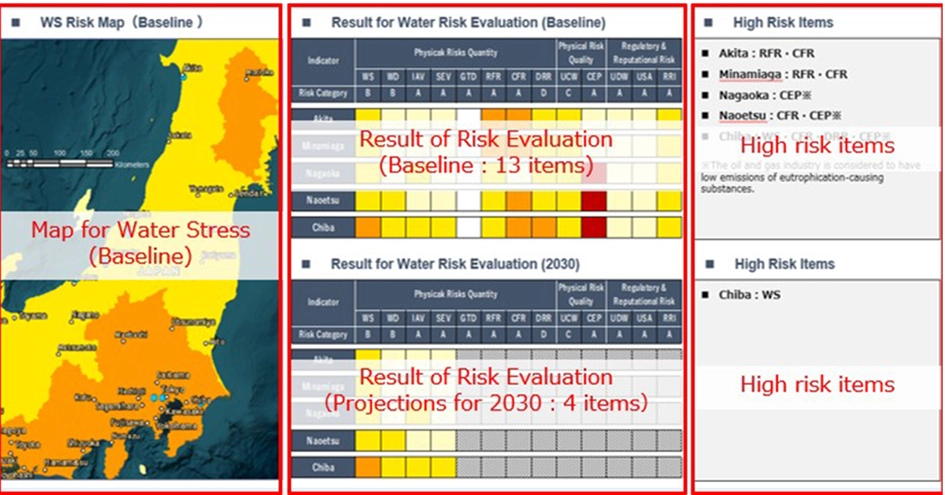Water Resource Management
With water management and water risk management1 being internationally recognized issues, we have prioritized proper water management as one of our Key Tasks.
Additionally, we have established and published our Policy and Commitments on Water Management through a resolution of the Board of Directors in December 2022.
1 Water risks: Water risks related to water supply necessary for current and future business continuity and the increasing rate of occurrence from abnormal weather associated with climate change
Policy and Commitments on Water Management
Our Policy
We consider the impact of our business on water resources and sustainability in local communities and promote efforts on impact mitigation and value creation.
Commitments
- Assess water-related risks in areas around operational sites
- We strive to understand the water-related risks at operating sites using internationally recognized risk assessment tools.
- We will develop and implement additional measures based on mitigation hierarchy for areas evaluated as high water-related risk areas.
- Restrict freshwater intake in high water stress2 areas
- We will limit freshwater intake where significant impact is expected on local water resources as a result of freshwater intake by our operating sites.
- Implement appropriate water management (water intake, usage, and drainage)
- We will strive to understand the status of water usage (water intake, drainage, usage) at our operating sites and implement the 3Rs (reuse, reduce, recycle).
- We will implement appropriate treatment and wastewater management for produced water and other associated wastewater.
- Collaborate with stakeholders
- We will collaborate with stakeholders to promote sustainable use of local water resources.
2 Ratio of water demand to available and renewable surfacewater/groundwater
Water Risk Assessment and Identification of High-Water Stress Areas
We annually check the water risk in the areas where our operator projects are located using AQUEDUCT, a water risk mapping tool developed by the World Resources Institute (WRI). The water risks we check include dependence on water resources, impacts of our projects, potential future changes in water demand and quality, future potential regulatory changes at a local level, and impacts on local stakeholders. As of the end of 2023, among the 26 production assets and one development project in which we have an interest, both the Abu Dhabi project and the Abadi project under development are located in areas with high water stress. However, in Abu Dhabi, no freshwater is being withdrawn due to the installation of seawater desalination equipment. For the Abadi project, we plan to install a seawater desalination plant as well, so that no freshwater will be taken from the project area.
Since local water risks are influenced by various factors and change over time, going forward we will continue to identify water risks. If we find water risk to be too high, we will plan and implement additional measures according to the mitigation hierarchy.
Indicators |
Indicator name |
Explanation |
|---|---|---|
Water Quantity Risk |
WS |
Water Stress |
WD |
Water Depletion |
|
IAV |
Interannual Variability |
|
SEV |
Seasonal Variability |
|
GTD |
Groundwater Table Decline |
|
RFR |
Riverine Flood Risk |
|
CFR |
Coastal Flood Risk |
|
DRR |
Drought Risk |
|
Water Quality Risk |
UCW |
Untreated Collected Wastewater |
CEP |
Coastal Eutrophication Potential |
|
Regulatory & Reputation |
UDW |
Unimproved/no drinking water |
USA |
Unimproved/no sanitation |
|
RRI |
ESG Evaluation Risk |

Initiatives Contributing to Improvement of Water Efficiency in the Water Use
In order to identify opportunities for improving water efficiency in each operator project, a water balance survey was conducted in 2023. This survey provided a detailed understanding and analysis of water usage for each facility and process, with the goal of reducing water consumption and improving wastewater quality.
Development of Effluent Water Treatment Technology
From FY2015 to FY2017, in collaboration with Chiyoda Corporation and METAWATER, and with the support of Japan Organization for Metals and Energy Security (JOGMEC), we conducted a pilot project at our Sotoasahikawa plant of the Akita Field Office to test a produced water treatment technology using ceramic membrane filtration. This technology is expected to further reduce the environmental impacts of water discharges from crude oil production. A joint follow-up study with JOGMEC was launched in FY2018, and a pilot test for commercial use of this technology is currently ongoing. To date, the test has confirmed sufficient capacity to treat the water effluent to the discharge standard for rivers as specified by Akita Prefecture.
As of March 31, 2022, we achieved a total operation time of 23,123 hours, constructed a produced water treatment facility, and continued to operate without incident or occupational injury throughout the entire operating period (approximately seven and a half years). The study was concluded in March 2023.
Education and Training on Efficient Water Management
We regularly provide education and training to the staff at our domestic operation sites to ensure proper water management practices and promote efficient water utilization.In 2022, we invited an outside lecturer to conduct a seminar on the topic of Mine Safety Act and Water Pollution Prevention Act.
